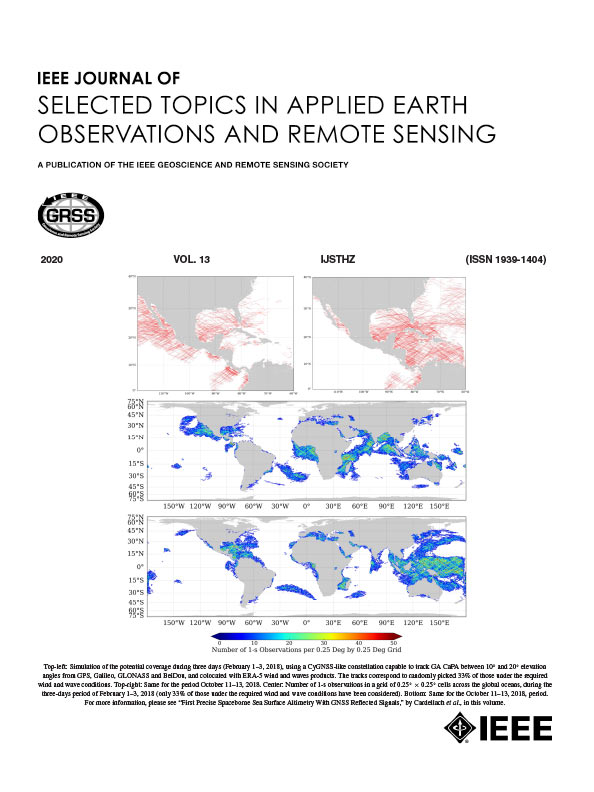RSEFormer: A Residual Squeeze-Excitation-Based Transformer for Pixelwise Hyperspectral Image Classification
IF 4.7
2区 地球科学
Q1 ENGINEERING, ELECTRICAL & ELECTRONIC
IEEE Journal of Selected Topics in Applied Earth Observations and Remote Sensing
Pub Date : 2025-04-11
DOI:10.1109/JSTARS.2025.3559190
引用次数: 0
Abstract
Hyperspectral image (HSI) classification plays an essential role in remote sensing image processing. Deep learning methods, especially the transformer, has achieved great success in HSI classification. However, due to the limited existing labeled data of HSI, the relation between objects is irregular in such a small dataset. Merely using the long-range attention based on transformers for learning may lead to bias results. In addition, it is challenging for current attention-based methods to extract attention between high-dimensional spectra, which affects the performance of the classification model. To this end, we propose a network that combines local spectral attention and global spatial-spectral attention, the residual depthwise separable squeeze-and-extraction transformer for HSI classification. Our framework integrates 3-D depthwise separable convolution (DSC) squeeze-and–excitation module, residual block, and sharpened attention vision transformer (SA-ViT) to extract spatial-spectral features from HSI. Three-dimensional DSC squeeze-and–excitation extracts spatial-spectral features and learns the local spectral implicit attention. Residual connection is introduced to hamper gradient vanishment during the network training. For global modeling, SA-ViT employs diagonal masking to eliminate self-token bias and learnable temperature parameters to sharpen attention score. Experimental results demonstrate that our method outperforms other approaches on five HSI benchmark datasets, achieving state-of-the-art performance.RSEFormer:一种基于残差挤压激励的高光谱图像分类变压器
高光谱图像分类在遥感图像处理中起着至关重要的作用。深度学习方法,尤其是变压器,在恒指分类中取得了巨大的成功。然而,由于HSI现有的标记数据有限,在如此小的数据集中,对象之间的关系是不规则的。仅仅使用基于变压器的远程注意进行学习可能会导致偏差结果。此外,现有的基于注意力的方法难以在高维光谱之间提取注意力,影响了分类模型的性能。为此,我们提出了一种结合局部光谱关注和全局空间光谱关注的网络,即残差深度可分挤压提取变压器,用于HSI分类。我们的框架集成了三维深度可分离卷积(DSC)压缩和激励模块,残差块和锐化注意视觉转换器(SA-ViT)来提取HSI的空间光谱特征。三维DSC压缩激励提取空间光谱特征,学习局部光谱隐式注意。在网络训练过程中引入残差连接,防止梯度消失。对于全局建模,SA-ViT采用对角掩模来消除自标记偏差,采用可学习的温度参数来提高注意力分数。实验结果表明,我们的方法在五个恒生指数基准数据集上优于其他方法,实现了最先进的性能。
本文章由计算机程序翻译,如有差异,请以英文原文为准。
求助全文
约1分钟内获得全文
求助全文
来源期刊
CiteScore
9.30
自引率
10.90%
发文量
563
审稿时长
4.7 months
期刊介绍:
The IEEE Journal of Selected Topics in Applied Earth Observations and Remote Sensing addresses the growing field of applications in Earth observations and remote sensing, and also provides a venue for the rapidly expanding special issues that are being sponsored by the IEEE Geosciences and Remote Sensing Society. The journal draws upon the experience of the highly successful “IEEE Transactions on Geoscience and Remote Sensing” and provide a complementary medium for the wide range of topics in applied earth observations. The ‘Applications’ areas encompasses the societal benefit areas of the Global Earth Observations Systems of Systems (GEOSS) program. Through deliberations over two years, ministers from 50 countries agreed to identify nine areas where Earth observation could positively impact the quality of life and health of their respective countries. Some of these are areas not traditionally addressed in the IEEE context. These include biodiversity, health and climate. Yet it is the skill sets of IEEE members, in areas such as observations, communications, computers, signal processing, standards and ocean engineering, that form the technical underpinnings of GEOSS. Thus, the Journal attracts a broad range of interests that serves both present members in new ways and expands the IEEE visibility into new areas.

 求助内容:
求助内容: 应助结果提醒方式:
应助结果提醒方式:


